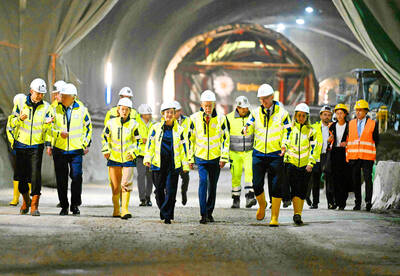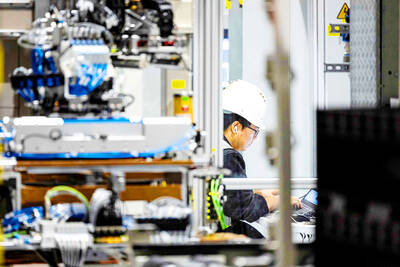Apple Inc sold fewer iPhones than expected in the first three months of the year, but that bare statistic hides an important bright spot for the company. The average selling price of an iPhone grew more than it has since the days of the iPhone 6.
Apple does not release figures for how many of each model it sells, but executives pointed to the premium-priced iPhone 7 Plus, which sells for up to US$969 fully loaded, as the key to boosting the amount it gets on average for each handset.
The average selling price of iPhones is important to Apple because the smartphone market is maturing and its growth slowing. Apple’s ability to get more cash for each smartphone sold is critical to growing its profits.
“One of the things that we did not get right was the mix between the iPhone 7 and the iPhone 7 Plus,” Apple chief executive officer Tim Cook told analysts on the company’s earnings conference call on Tuesday, in response to a question about how supply of its top-end handset was constrained during the holiday shopping season.
“The demand was much stronger for the 7 Plus than we had predicted and so it took us a little while to adjust all the way back through the supply chain and to bring iPhone 7 Plus into balance, which occurred this past quarter,” he said.
The popularity of the iPhone 7 Plus represents a triumph for Apple with a new departure: Packing a unique feature into its most expensive iPhone.
The iPhone 6 Plus differed from its smaller sibling only in screen size, but the 7 Plus model has a physically different camera that enables what Apple calls “portrait mode” for taking shots with a blurred background — a feature more commonly found on large, expensive digital cameras.
It is a strategy Apple could use again. Many analysts believe the company is to reserve certain features for the premium-priced model of its next, eagerly awaited iPhone — such as a higher-quality display — that could sell for more than US$1,000.
The 10th-anniversary iPhone range might also have features such as wireless charging and 3D facial recognition.
Apple sold 50.76 million iPhones in its fiscal second quarter ended April 1, down from 51.19 million in the same period the previous year.
Analysts on average had estimated iPhone sales of 52.27 million, according to financial data and analytics firm FactSet.
Despite the dip in unit sales, iPhone revenues rose 1.2 percent in the quarter, helped by a higher average selling price.
The company’s net income rose to US$11.03 billion, or US$2.10 per share, compared with US$10.52 billion, or US$1.90 per share, in the same period last year.
Analysts had on average expected US$2.02 per share, according to Thomson Reuters I/B/E/S.
Revenue rose 4.6 percent to US$52.90 billion in the quarter, compared with analysts’ average estimate of US$53.02 billion.
Apple’s revenue from the Greater China region fell 14.1 percent to US$10.73 billion in the quarter, as cheaper rivals in the region chipped away at sales.
Apple chief financial officer Luca Maestri said that sales of Apple Macs and the company’s services were strong in China during the quarter.
“The performance we’re seeing in China should get better going forward this year,” he said.

CHIP RACE: Three years of overbroad export controls drove foreign competitors to pursue their own AI chips, and ‘cost US taxpayers billions of dollars,’ Nvidia said China has figured out the US strategy for allowing it to buy Nvidia Corp’s H200s and is rejecting the artificial intelligence (AI) chip in favor of domestically developed semiconductors, White House AI adviser David Sacks said, citing news reports. US President Donald Trump on Monday said that he would allow shipments of Nvidia’s H200 chips to China, part of an administration effort backed by Sacks to challenge Chinese tech champions such as Huawei Technologies Co (華為) by bringing US competition to their home market. On Friday, Sacks signaled that he was uncertain about whether that approach would work. “They’re rejecting our chips,” Sacks

It is challenging to build infrastructure in much of Europe. Constrained budgets and polarized politics tend to undermine long-term projects, forcing officials to react to emergencies rather than plan for the future. Not in Austria. Today, the country is to officially open its Koralmbahn tunnel, the 5.9 billion euro (US$6.9 billion) centerpiece of a groundbreaking new railway that will eventually run from Poland’s Baltic coast to the Adriatic Sea, transforming travel within Austria and positioning the Alpine nation at the forefront of logistics in Europe. “It is Austria’s biggest socio-economic experiment in over a century,” said Eric Kirschner, an economist at Graz-based Joanneum

BUBBLE? Only a handful of companies are seeing rapid revenue growth and higher valuations, and it is not enough to call the AI trend a transformation, an analyst said Artificial intelligence (AI) is entering a more challenging phase next year as companies move beyond experimentation and begin demanding clear financial returns from a technology that has delivered big gains to only a small group of early adopters, PricewaterhouseCoopers (PwC) Taiwan said yesterday. Most organizations have been able to justify AI investments through cost recovery or modest efficiency gains, but few have achieved meaningful revenue growth or long-term competitive advantage, the consultancy said in its 2026 AI Business Predictions report. This growing performance gap is forcing executives to reconsider how AI is deployed across their organizations, it said. “Many companies

France is developing domestic production of electric vehicle (EV) batteries with an eye on industrial independence, but Asian experts are proving key in launching operations. In the Verkor factory outside the northern city of Dunkirk, which was inaugurated on Thursday, foreign specialists, notably from South Korea and Malaysia, are training the local staff. Verkor is the third battery gigafactory to open in northern France in a region that has become known as “Battery Valley.” At the Automotive Energy Supply Corp (AESC) factory near the city of Douai, where production has been under way for several months, Chinese engineers and technicians supervise French recruits. “They